What is Self-Harm?
- It is the process of causing harm to oneself.
- The subject feels the need to harm himself or herself for physiological, internal reasons.
- The most common form of self-harm – cuts and bruises.
- 7-14% of adolescents suffer from self-harm.
The process of causing harm to oneself is one of the most important psychological. This phenomenon consists of the intentional infliction of damage to one’s own body. The subject feels the need to harm himself or herself for reasons that generally are not related to the plan to commit suicide. The most common form of self-harm is cutting and bruising on the hands and other parts of the body. Even though self-harm can occur among people of any age, the spread of this phenomenon among adolescents is especially pronounced, since it affects about 7-14 percent of them (Moorey, 2010). All the more important is the attention paid to this problem and raising the awareness of others about it.
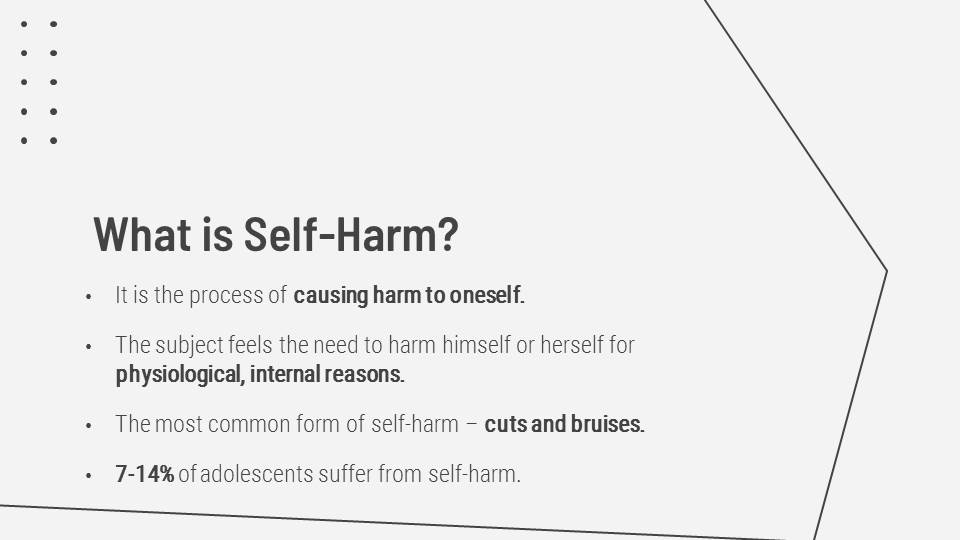
What are the Reasons?
- All factors are psychological and internal.
- Often self-harm is a way of shifting attention from problems.
- Cause of self-harm – anxiety, depression, social difficulties.
- Other causes – severepsychological conditions.
The reason for self-harm can be many factors. In the first place, self-harm can serve as a way of shifting attention from other problems (Moorey, 2010). When a person inflicts physical pain on himself, psychological suffering temporarily dulls. Thus, the cause of such actions may be anxiety, depression, and individual social difficulties. For example, having bullying at school or family, friends who also engage in self-harm, or a stressful event can provoke teenagers to harm themselves (Waller, 2019). Other possible causes of this behavior include attention deficit hyperactivity disorder and severe psychological abnormalities such as autism and schizophrenia.
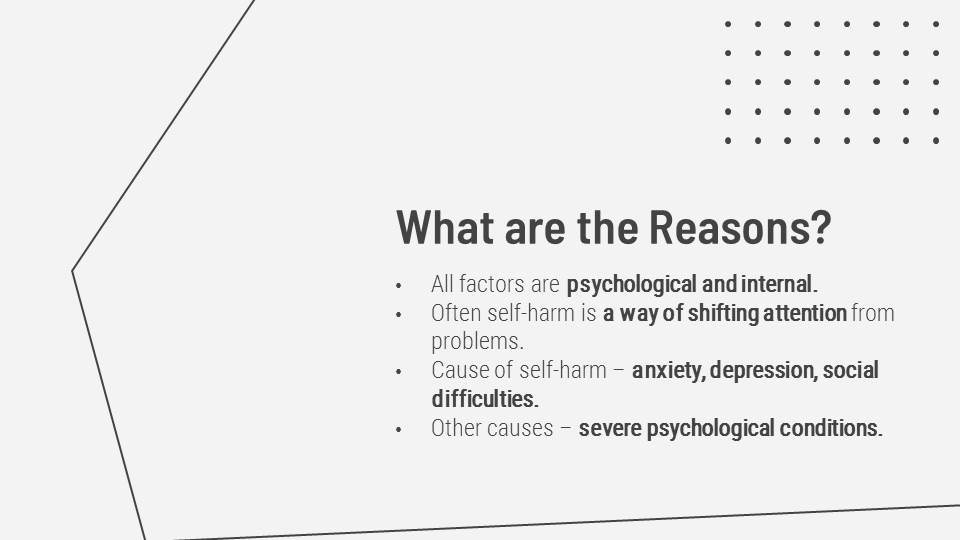
What are the Indicators of Self-Harm?
- Hiding the injuries by isolation.
- Avoiding being seen in open suits, such as swimming ones.
- Separation and remoteness.
- Aggression, expressions of worthlessness and uselessness.
It is necessary to know the signals by which self-harm can be detected. The vast majority of suffering adolescents hide their injuries, as self-harm can be met with condemnation and alienation of a person from society. First of all, there are several physical signals, such as isolation (Waller, 2019). In the case of cuts in the hands of teenagers, they will most likely wear clothing with long sleeves. Most likely, the person, in this case, will also avoid as open suits as possible, such as swimming suits, as well as the process of changing clothes next to other people (Waller, 2019). However, some psychological markers can help determine this condition. First of all, these signals can be expressed in separation and remoteness from others. Often aggression is added to these symptoms, as well as an expression of a sense of worthlessness and uselessness. If a person continually blames himself or herself for everything, this should be a reason for concern.
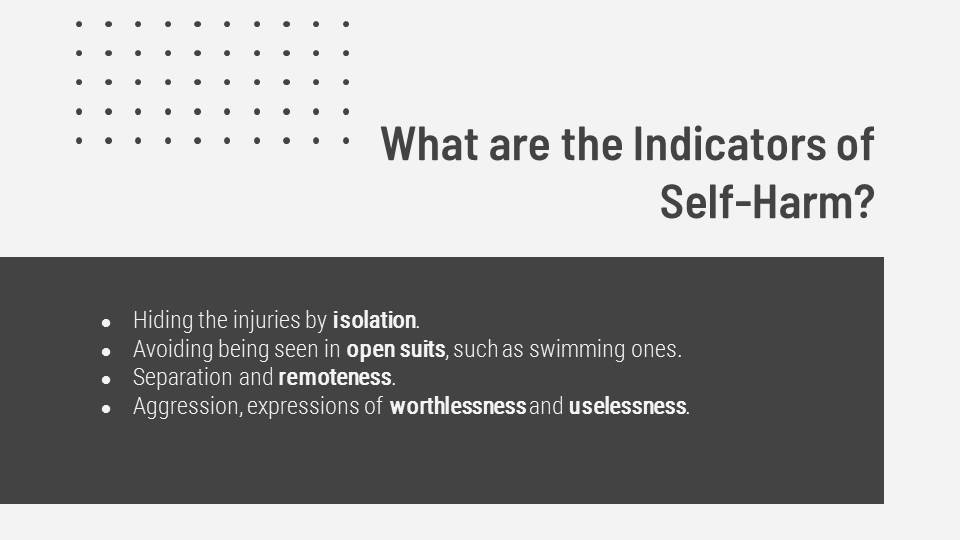
What are Appropriate Interventions?
First Aid Measures:
- Careful analysis of the student’s physiological state and treating the current injuries.
Psychological Assistance:
- Providing support by building friendly and trusting relationships.
If self-harm cases are confirmed, appropriate measures must be taken as soon as possible. First, existing wounds should be treated following first aid measures. Secondly, it is necessary to carefully analyze the child’s current state, since there is a danger of the influence of any psychotropic substances. The most reasonable in this case is the question of whether a person feels pain. As mentioned above, self-harm is often used as a means of distracting from problems, but this does not mean that a person wants to experience pain regularly (Waller, 2019). In addition to urgent physical measures, psychological assistance is necessary. It is essential to ensure the student’s confidentiality since the personal space of a person should not be violated. It is critical to provide support, build trusting relationships.
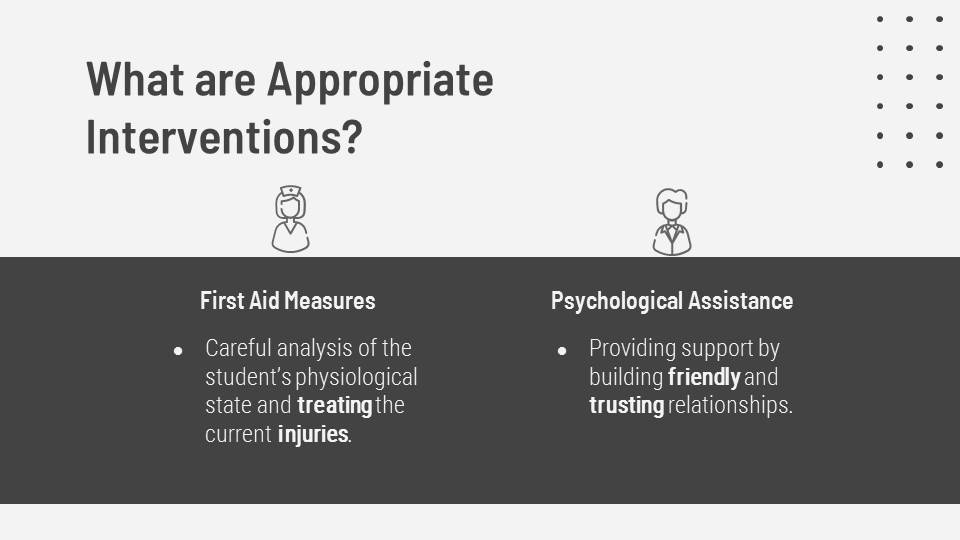
What are the Follow-Up Steps?
- Engage the family in the process of therapy and build of supportiverelationships.
- Provide the opportunity to feel comfortable.
- Suggest interestingactivities to shift attention to them.
Self-harm, as a phenomenon, often appears due to the inability to realize feelings and problems. In this case, you should make a list of activities that can serve as an alternative to mutilation. These should include things interesting to the teenager, and among such activities may be, for example, creativity, meditation, relaxing activities. Safe actions can also help, for example, sports, exercises, or punches on some soft objects like pillows. The most important thing is to provide the teenager with the opportunity to feel comfortable and not to keep all their problems and emotions in themselves. The family can be especially helpful in this matter since therapy combined with activities to strengthen the family (Fortune et al., 2016). Accordingly, building relationships based on support can help to cope with internal problems. Thus, it is necessary to find a personal approach to each teenager with the help of a trusting relationship. It is also crucial to provide them with safe ways to cope with emotions through activities or communication with other people.
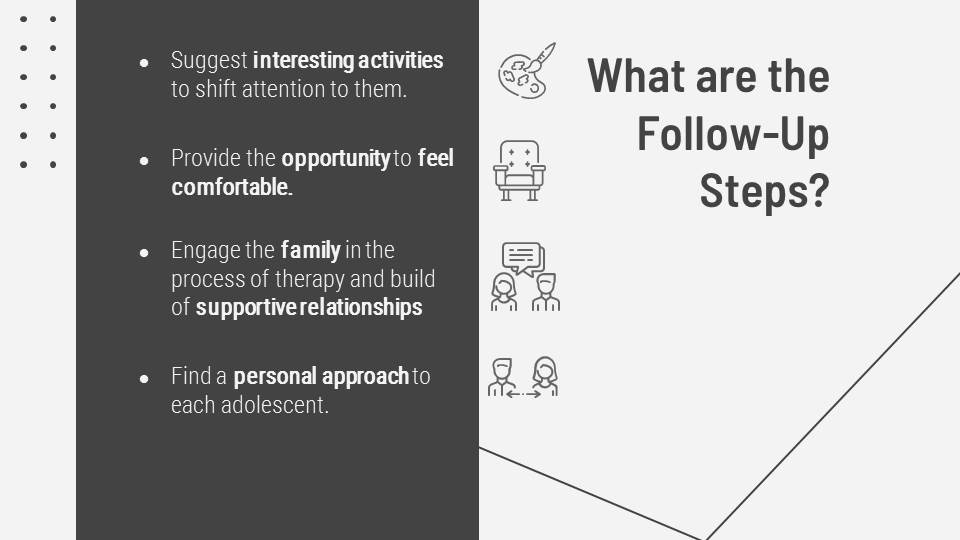
References
Fortune, S., Cottrell, D., & Fife, S. (2016). Family factors associated with adolescent self‐harm: A narrative review. Journal of Family Therapy, 38(2), 226-256.
Moorey, S. (2010). Managing the unmanageable: Cognitive behaviour therapy for deliberate self-harm. Psychoanalytic Psychotherapy, 24(2), 135- 149.
Waller, C. (2019). Self-harm: How teachers should respond. SecEd, 2019(13), 12-13. Web.